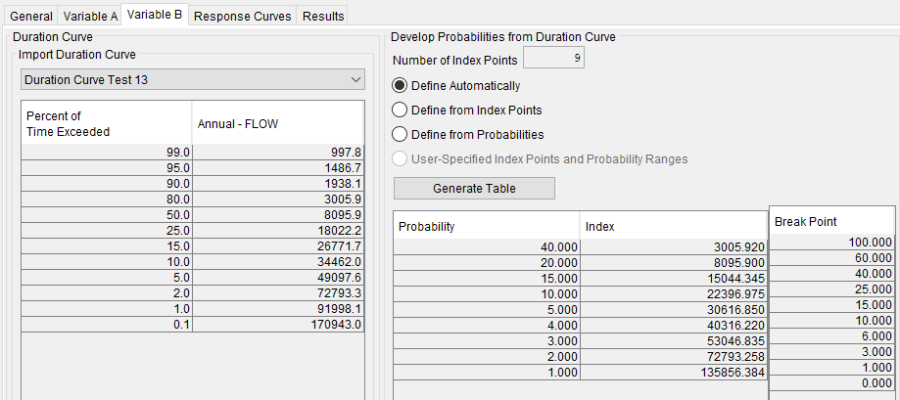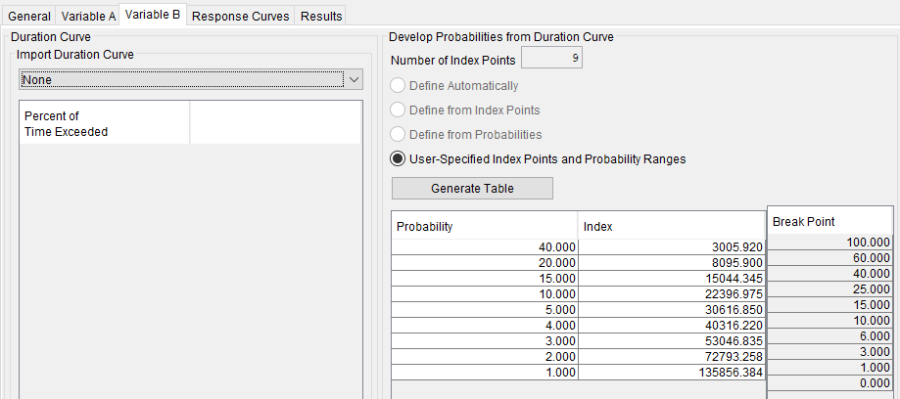Download PDF
Download page Variable B.
Variable B
The Variable B tab is used to define the duration curve for variable B and the index points with an associated probability. The index points will be used by the user when developing the response curves (response of variable C to each combination of variables A and B). The associated probability represents the proportion of time that each index point can be expected to occur.
As shown in Figure 1, the left side of the variable B tab is used to select the duration curve from an existing Duration Analysis. Once selected, the program populates the duration curve table. Press the Plot button located at the lower left corner of the Variable B tab to open a plot of the variable B duration curve.

After the duration curve has been selected, the right side of the variable B tab is used to define the index points and associated probabilities used to discretize the duration curve. The number of index points is defined on the General tab and is included on the Variable B tab to let the user know how many index points must be defined in the table. There are 4 methods for defining the index values and the associated probabilities. The user selects one of the methods, edits the table, and then clicks the Generate Table button in order for the program to finish populating the table. The following text describes each method.
Define Automatically. The program will use a predefined pattern of probability ranges when this option is selected, as contained in Table 1, to populate the Probability column. The pattern is dependent on the number of index points and the default probability patterns do not extend beyond nine index points. If more than nine index points have been selected for the analysis, then use one of the other methods for defining the index points and associated probabilities. The program will compute the Index and Break Point columns when the Generate Table button is pressed. The Break Point column is computed using the probability pattern. The first row in this column is always 100. The second break point is computed by subtracting the first probability value from the first break point value. The third break point is computed by subtracting the second probability value from the second break point value. This procedure is followed until the last break point is computed; it should always have a value of 0. The Index values are taken from the duration curve at the midpoint between each break point range. For example, if the first break point was 100 and the second was 60 then the first Index value would be the value from the duration curve at 80 percent time exceeded.
Table 1. Default Probability Patterns.
Index | Number of Index Points | ||||||
|---|---|---|---|---|---|---|---|
3 | 4 | 5 | 6 | 7 | 8 | 9 | |
1 | 20 | 15 | 45 | 35 | 35 | 35 | 40 |
2 | 60 | 35 | 40 | 30 | 25 | 20 | 20 |
3 | 10 | 35 | 10 | 20 | 20 | 15 | 15 |
4 | 15 | 4 | 10 | 10 | 10 | 10 | |
5 | 1 | 4 | 6 | 10 | 5 | ||
6 | 1 | 3 | 6 | 4 | |||
7 | 1 | 3 | 3 | ||||
8 | 1 | 3 | |||||
9 | 1 | ||||||
Define from Index Points. The number of rows is set by the number of index points. In this case, the Index column is edited by the user; the user must enter an index value in each row. When the Generate Table button is pressed, the program will compute the Break Point and the Probability values. First, the program will use the selected duration curve and interpolate a percent of time exceeded for each user-defined index value. Then break points are computed so that they are half way between the percent of time exceeded values (the first and last break points will be 100 and 0). The probability values are computed based on the break points. For example, the first probability value is computed by subtracting the second break point value from the first. The second probability value is computed by subtracting the third break point value from the second. This procedure is followed until the last probability value is computed.
Define from Probabilities. The number of rows is set by the number of index points. In this case, the Probability column is edited by the user; the user must enter a probability value in each row (the probability values should add up to 100). When the Generate Table button is pressed, the Break Point column is computed using the user-entered probability pattern. For example, the first row in the break point column is 100; therefore, the second break point is computed by subtracting the first probability value from the first break point value. The third break point is computed by subtracting the second probability value from the second break point value. This procedure is followed until the last break point is computed; it should always have a value of 0. The Index values are taken from the duration curve at the midpoint between each break point range. For example, if the first break point was 100 and the second was 60 then the first Index value would be the value from the duration curve at 80 percent time exceeded.
User-Specified Index Points and Probability Ranges. This option can only be selected when the user does not select an existing Duration Curve to import. This would be applicable for the case where the user developed the duration curve outside of HEC-SSP and developed the index points and associated probabilities. As shown in Figure 2, the user must specify both the Probability and Index values; the user must enter values in each row. When the Generate Table button is pressed, the Break Point column is computed using the user-entered probability pattern. For example, the first row in the break point column is 100; therefore, the second break point is computed by subtracting the first probability value from the first break point value. The third break point is computed by subtracting the second probability value from the second break point value. This procedure is followed until the last break point is computed; it should always have a value of 0.
